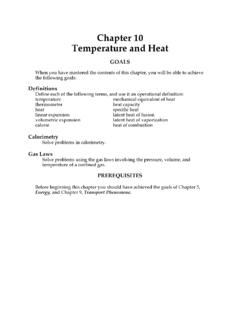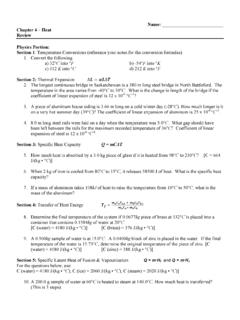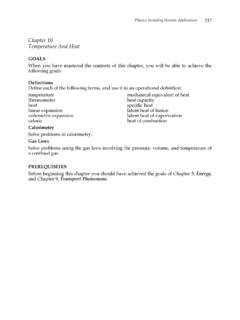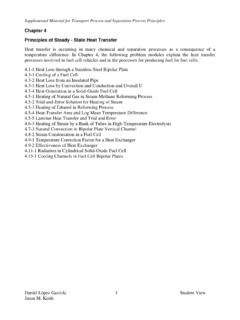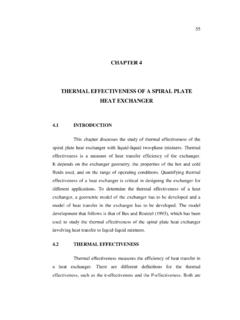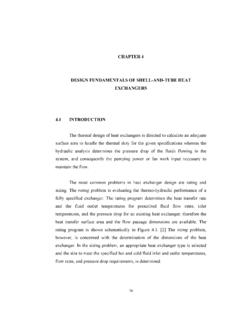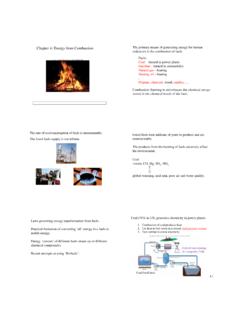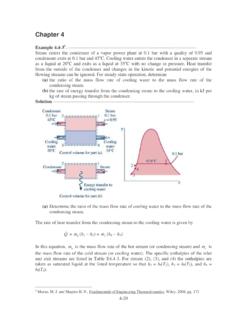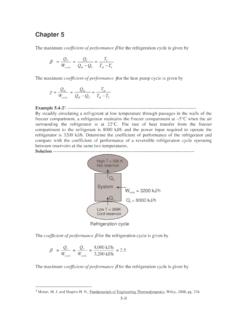Transcription of Chapter 4 Convection - MIT PAOC
1 Chapter 4 ConvectionWe learned in Chapters 2 and 3 that terrestrial radiation emanates to spaceprimarily from the upper troposphere, rather than the ground; much of whatradiates from the surface is absorbed within the atmosphere. The surfaceis thus warmed by both direct solar radiation and downwelling terrestrialradiation from the atmosphere. In consequence, in radiative equilibrium, thesurface is warmer than the overlying atmosphere. However, it turns out thatthis state isunstableto convective motions which develop, as sketched , and transport heat upward from the surface. In the troposphere,therefore, equilibrium is not established solely by radiative processes. Inthis Chapter , we discuss the nature of the convective process and its role indetermining theradiative-convectivebalance of the we are about to explore, the conditions under which Convection occursdepend on the characteristics of thefluid; consequently, the theory appropri-ate in a moist, compressible atmosphere is somewhat more complicated thanin an incompressible medium like water.
2 Accordingly, we will discuss con-vection in a sequence of cases of increasing complexity. After making somegeneral remarks about the nature of Convection , we will describe the incom-pressible case using a theoretical approach and a laboratory experiment in Section Convection in an unsaturated compressible atmosphere isdiscussed in Section ; the effects of latent heat consequent on condensationof moisture are addressed in Section 4. CONVECTIONF igure :Solar radiation warms the earth s surface, triggering Convection whichcarries heat vertically to the emission level from which, because the atmosphereabove this level is transparent in the IR, energy can be radiated out to space. Thesurface temperature of about288 K,issignificantly higher than the temperature atthe emission level,255 K, because the energyflux from the surface must balancenot just the incoming solar radiation butalso downwelling IR radiation from theatmosphere above.
3 An idealized radiative equilibrium temperature profile,T(z)is superimposed (cf. ). THE NATURE OF CONVECTION75 Figure :Schematic of shallow Convection in afluidsuchaswatertriggeredbywarming from below and/or cooling from The nature of Convection in a shallowfluidWhen afluid such as water is heated from below (or, in fact, cooled fromabove), it develops overturning motions. It may seem obvious that this mustoccur, because the tendency of the heating (or cooling) is to make thefluidtop-heavy1. Consider the shallow, horizontally infinite,fluid shown in the heating be applied uniformly at the base; then we may expect thefluid to have a horizontally uniform temperature, soT=T(z)only. Thiswill be top-heavy (warmer, and therefore lighter,fluid below cold, densefluid above).
4 But as we have seen, gravitational forces can be balanced1 John William Strutt Lord Rayleigh (1842-1919) set the studyof Convection on afirm theoretical basis in his seminal studies in the 1900 s. In one of hislast articles, published in 1916, he attempted to explain what is now known as Rayleigh-Benard Convection . His work remains the starting point for most of the modern theoriesof 4. CONVECTIONby a vertical pressure gradient in hydrostatic balance with the densityfield[Eq.( )], in which case anyfluid parcel will experience zero net force, even ifheavyfluid is above light. Nevertheless, observations and experiments showthat Convection develops2,assketchedinthefigure. Why? There are twoparts to the question:1. Why do motions develop, when the equilibrium state discussed abovehas no net forces anywhere?
5 2. Why are the motions horizontally inhomogeneous when the externalforcing (the heating) is horizontally uniform?The answer is that the motions are not directly forced, but (like manytypesofmotionintheatmosphereandocean )arisefromaninstabilityofthefluid in the presence of heating. We therefore begin our discussion ofconvection by reminding ourselves of the nature of InstabilityFor any system that possesses some equilibrium state, instability will ariseif, in response to a perturbation, the system tends to drive the perturbationfurther from the equilibrium state. A simple and familiar example is a ballonacurvedsurface, ball that is stationary and exactly at a peak (point A,x=xA)isinequilibrium but, of course, this state is unstable. If the ball is displaced asmall distance xfrom A, itfinds itself on a downward slope, and thereforeis accelerated further.
6 To be specific, the component of gravitational accel-eration along the slope is, for small slope, + xis, making a Taylor expansion aboutx=xA(see Section ),dhdx(xA+ x)'dhdx(xA)+ d2hdx2 A x= d2hdx2 A xfor small x, since the slope is zero atxA. Hence the equation of motion forthe ball isd2dt2( x)= g h x= g d2hdx2 A x .( )2We are considering here the stability of afluid that has no (or, rather, very small)viscosity and diffusivity. Rayleigh noted that Convection of a viscousfluidheatedfrombelow does not always occur; for example, oatmeal or polenta burns if it is not kept stirredbecause the high viscosity can prevent Convection THE NATURE OF CONVECTION77 Figure :Stability and instability of a ball on a curved has solutions x(t)=c1e +t+c2e t( )wherec1,c2are constants and = s g d2hdx2 a peak, wheredh/dxchanges from positive to negative with increasingx,d2h/dx2<0,bothrootsfor are real, and thefirst term in Eq.
7 ( ),describes an exponentially growing perturbation; the state (of the ball atA in ) isunstable. (Exponential growth will occur only for as longas our assumption of a small perturbation is valid and will obviously breakdown before the ball reaches a valley.) On the other hand, for an equilibriumstate in whichd2h/dx2>0(such as the valley at B), the roots for areimaginary, Eq.( ) yields oscillatory solutions and the state isstable anyperturbation will simply produce an oscillation as the ball rolls back andforth across the consideration of the energetics of our ball is also instructive. Ratherthan writing down and solving differential equations describing the motionof the ball, as in Eq.( ), the stability condition can be deduced by a con-sideration of the energetics.
8 If we perturb the ball in a valley, it moves upthe hill and we have to do work (add energy) to increase the potential energy78 Chapter 4. CONVECTIONof the ball. Hence, in the absence of any external energy source, the ball willreturn to its position at the bottom of the valley. But if the ball is perturbedon a crest it moves downslope, its potential energydecreasesand its kineticenergyincreases. Thus we may deduce that stateAin is unstableand stateBis we shall now see, the state of heavyfluid over light is an unstable one;thefluid will overturn and return itself to a stable state of lower Convectioninwater(an almost-incompressiblefluid) BuoyancyObjects that are lighter than water bounce back to the surface when im-mersed, as has been understood since the time of Archimedes (287-212 BC).
9 Butwhatifthe object isaparcel3of thefluid itself, as sketched in the stability of such a parcel in an incompressible liquid. We willsuppose that density depends on temperature and not on pressure. Imaginethat the parcel shaded in is warmer, and hence less dense, than will be in hydrostatic balance. Since is uniform above, the pressure at A1,AandA2will be the same. But,because there is lighterfluidinthecolumnaboveBthanaboveei therpointB1or B2, from Eq.( ) we see that the hydrostatic pressure at B will be lessthan at B1and has a tendency toflow from regions of highpressure to low pressure,fluid will begin to move toward the low pressureregion at B and tend to equalize the pressure along B1BB2; the pressure atB will tend to increase and apply an upward force to the buoyantfluid whichwill therefore begin to move upwards.
10 Thus the lightfluid will fact (as we will see in Section ) the acceleration of the parcel offluid is notgbutg / Pwhere =( P E), Pis the density of theparcel and Eis the density of the environment. It is common to speak ofthe buoyancy,b, of the parcel, defined as3A parcel offluid is imagined to have a small butfinite dimension, to be thermallyisolated from the environment and always to be at the same pressure as its Convection IN WATER(AN ALMOST-INCOMPRESSIBLE FLUID)79 Figure :A parcel of light, buoyantfluid surrounded by resting, homogeneous,heavierfluid in hydrostatic balance, Eq.( ). Thefluid above points A1,AandA2has the same density and hence, as can be deduced by consideration of hydrostaticbalance, the pressures at the A points are all the same.
